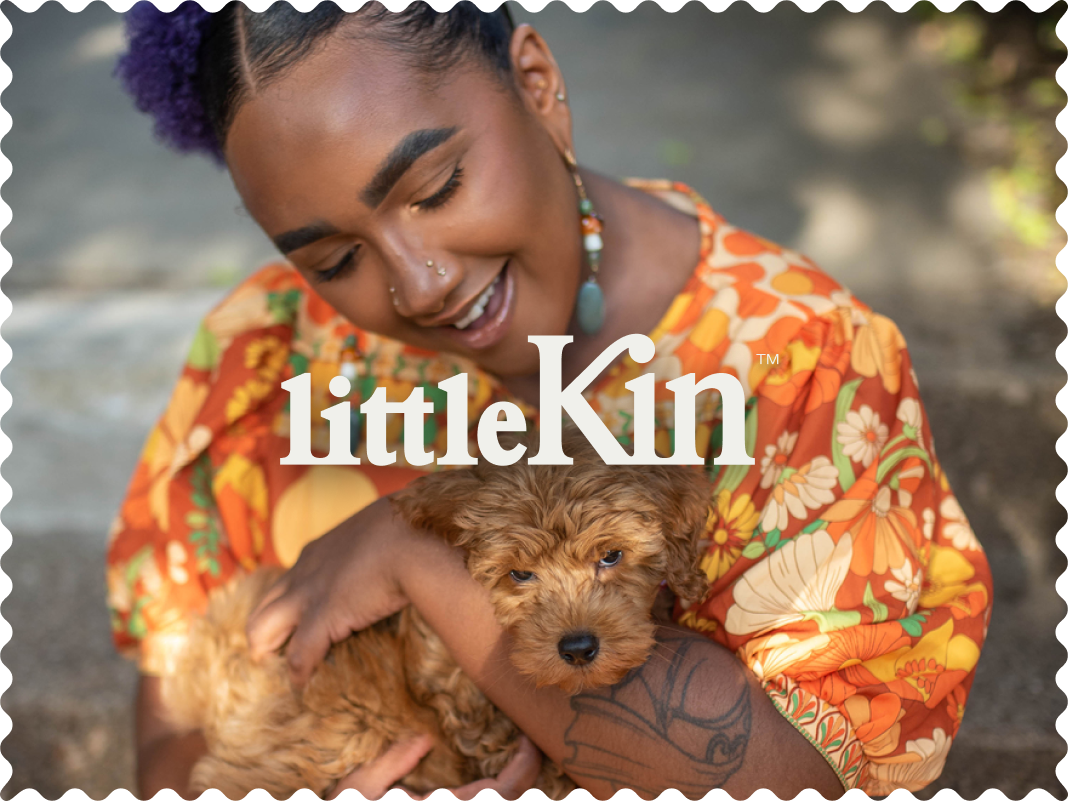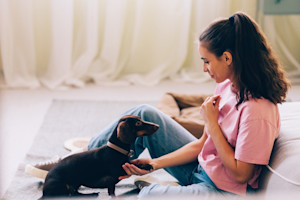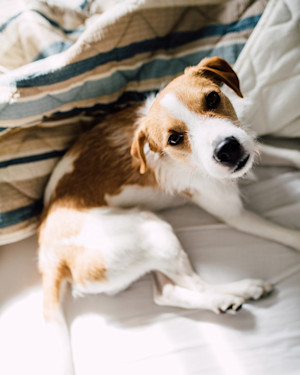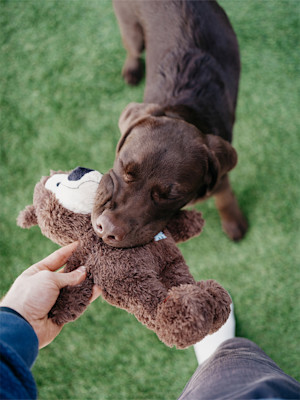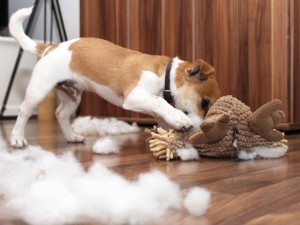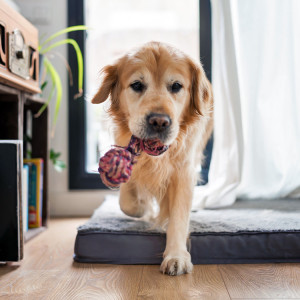I’m a Vet and I Would Never Leave My Dog Unsupervised With This Toy
This little-known flaw can cause terrible consequences
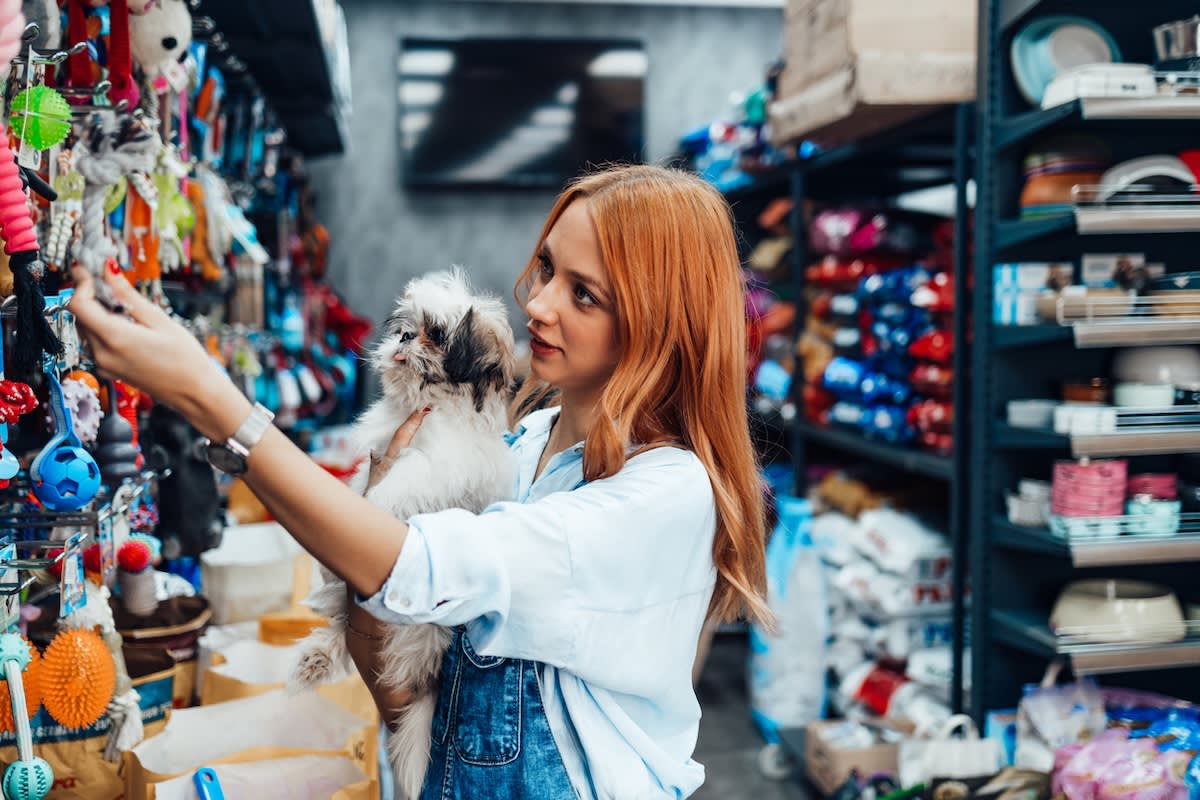
Share Article
I am a small animal vet entrusted with the care of a whole range of animals in the south of Scotland. Although I love my job, it does mean that I often come across preventable ailments and injuries in animals caused by all sorts of things that pet parents didn’t necessarily realise weren’t safe for their dog.
Because of this, I now have a long list of things that I would never let my own pets do for their safety. Number one on my list? Play with a fillable chew toy without my supervision. Why? Let’s look into it!
What is a stuffable dog toy?
Fillable or stuffable toys are made from strong, non-toxic rubber and can be filled with treats for dogs. They provide a great source of enrichment and enjoyment for your pup and can give them hours of fun. Pet parents can fill them up with treats or lickable fillings, or even just use their own pup’s usual dry or wet food.
You can even freeze the toy when it’s filled with wet food for pets to enjoy on hot days as they spend hours licking out the tasty treat as it thaws.
The most famous brand of this type of toy is KONG. But it isn’t KONGs that we‘re talking about here – it’s the off-brand versions that can cause trouble.
Why are off-brand KONGs dangerous?
While these fillable toys can be a great way to enrich your dog’s time (and keep them quiet for a while!), if they are not used correctly or if the toy is defective then they have the potential to cause severe injury to your dog. If you look closely at your dog’s KONG or KONG-like toy, you will see a large hole where you are able to fill the inside with food or a lickable treat. If you turn the toy over you should see another smaller hole on the other side. If you can’t find another hole, do not buy this toy, or throw it away! This seemingly innocuous additional hole has a safety purpose.
If a toy doesn’t have this second hole, a vacuum can form when a dog licks inside for treats, causing their tongue to get stuck. This may sound funny, but it definitely isn’t. At my practice, we often treat pets with injuries such as tongue lacerations from toys that seemed safe, and in some cases we’ve even had to remove toys stuck around dog’s tongues or jaws.
Dog’s tongues can swell when stuck in the toy making it almost impossible to remove without injuring the tongue further. The toy may even have to be cut open to remove. If it is forcibly removed by a non-medical professional, the damage can be severe enough for partial or full tongue amputationsopens in new tab, which is called a glossectomyopens in new tab and can have life changing implications and limitations.
How to use a stuffable dog toy safely
When buying these toys for your dog, check to make sure there is a second hole to stop this vacuum being created. KONG-branded products have the second hole in their design for safety but make sure to double check before you let your dog use it if you are buying an unknown brand or product online which you can’t physically check. There are plenty of reliable brands out there, but don’t waste money on the wrong one.
Even if the toy has the additional safety hole, it still needs to be used correctly to ensure the hole does not become covered. When filling the toy for freezing, you must remember to stick a chopstick or straw through the holes as you fill it and remove before giving it to your pet to make sure an air hole is present all the way through.
The greatest risk of injury is if your dog panics when their tongue becomes stuck and they injure themselves trying to get unstuck. This is why it’s always best if you’re there when they’re using the toy, so you can intervene.
If your pup somehow gets their tongue stuck, act immediately. Do your best to keep them calm with a soothing voice and try to see where they have the toy stuck. If suction has caused your pet’s tongue to get stuck inside the toy, you must break the vacuum seal to release it safely. If safe and possible, slide a chopstick (or something similarly smooth so as not to injure the tongue), along the side of the tongue, or through the secondary hole to create a space for airflow.
It can sometimes help to warm the rubber of the toy by wrapping it with a warm towel to make the rubber expand. If this doesn’t work (be gentle!) or if your dog is too distressed, the next step is an urgent vet visit to get your pup comfortable as quickly as possible. Your vets will be able to give your dog pain relief and sedation if needed in order to remove the toy safely and check for any lacerations or damage that may require further treatmentopens in new tab.
Alternative toys
There are plenty of other options for at-home enrichment, although if used correctly these fillable toys are a great product for your dog. Safer alternatives without the suction risk include lick mats or fillable toys with ridges on the outside where you can smear soft treats. When buying these toys, double check the safety aspects, and as accidents can happen. My advice? Stick to the big brand names and only let your dog use toys when supervised.
Please contact your vet ASAP if there’s any sign your pup has got their tongue stuck in a toy or the toy is stuck over their jaw. The sooner they are seen the better!
References
Buelow, Mary E., et al. “Lingual Lesions in the Dog and Cat: Recognition, Diagnosis, and Treatment.” Journal of Veterinary Dentistry, vol. 28, no. 3, Sept. 2011, pp. 151–62, https://doi.org/10.1177/089875641102800302opens in new tab.
Dvorak, Laura D., et al. “Major Glossectomy in Dogs: A Case Series and Proposed Classification Systemopens in new tab.” Journal of the American Animal Hospital Association, vol. 40, no. 4, American Animal Hospital Association, July 2004, pp. 331–37, https://doi.org/10.5326/0400331.
Rubio, A., et al. “Tongue Entrapment by Chew Toys in Two Dogsopens in new tab.” Journal of Small Animal Practice, vol. 51, no. 10, Oct. 2010, pp. 558–60, https://doi.org/10.1111/j.1748-5827.2010.00986.x.

Dr Josephine Corrick, BVMSci, BSc, MRCVS
Dr Josephine Corrick, BVMSci, BSc, MRCVS is a veterinary surgeon based in the south of Scotland where she has been since graduating from the University of Surrey. She enjoys working in general practice treating small animals. Her particular interests include diagnostic imaging and the treatment of wildlife.
Having found a passion for veterinary medicine after doing a degree in Equine Sports Science she still enjoys including horses in her life by spending time with her highland ponies. Alongside her clinical work, she helps run a smallholding caring for rare breed sheep and exploring the Scottish countryside with her young Cocker Spaniel.
Related articles
![a woman with thick brown hair in a ponytail teaches a daschund a trick]()
I’m a Vet and I Would Never Teach My Dachshund This Common Trick
It could cause serious health problems
![Small brown and white dog lying in a bed looking up at the camera]()
I’m a Dog Behaviourist, Here’s When I Would Ban Bed Sharing
The five reasons not to co-sleep with your pup
![Dog playing with toy]()
Why You Should Be Washing Your Dog’s Toys (And How to Do It Right)
Because that slobbery plushie isn’t going to clean itself
![White and brown puppy destroyed a stuffed toy]()
5 Ways to Stop Your Puppy From Ripping Up Their Toys
How to teach your dog to enjoy, not destroy, their toys
Why Does My Dog Bring Me Toys?
It’s more than just an adorable habit…
